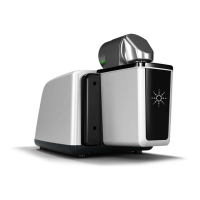Analyzing Samples
Agilent Cary 630 FTIR Spectrometer User’s Guide 29
CAUTION
The Diamond ATR accessory windows are made from type IIa synthetic diamond,
which is extremely chemically-resistant. However, it is still possible the diamond
crystal or metal mounting plate can be damaged by extreme samples. Only
measure samples with a pH between 1 and 14. Do not leave extremely acidic
samples on the metal mounting plate for an extended time.
CAUTION
Although diamond is a very hard material, the ATR window is relatively thin
(0.5 mm or less) and can crack under extreme pressure conditions. Ensure that
the sample makes contact with the entire surface area of the diamond and not
just a point within the diamond. Avoid using the sample press on samples that
may be sharp or pointed.
If the sample is a liquid or paste, the sample press does not need to be
used at all. In this case, you are now ready to proceed with the
analysis.
If the sample is a powder or solid, the sample press must be in contact
with the sample. To make contact, rotate the sample press knob in a
clockwise direction until it reaches the detent (click-in) position. The
sample press arm uses a slip clutch mechanism, whereby the
maximum applied pressure cannot be surpassed — once maximum
pressure has been reached, the slip clutch mechanism will click and
not allow any extra pressure to be exerted on the sample.
4 For instructions on collecting a sample spectrum using the
software, refer to the Agilent MicroLab PC Software User’s Guide.
5 After completing the sample measurement, immediately clean the
sample from the accessory using the instructions provided on
Page 27. It is important to make sure both the diamond sampling
window and the sample press tip are free of any residue from the
previous sample.
For instructions on reviewing results and handling sample data, refer
to the Agilent MicroLab PC Software User’s Guide.

